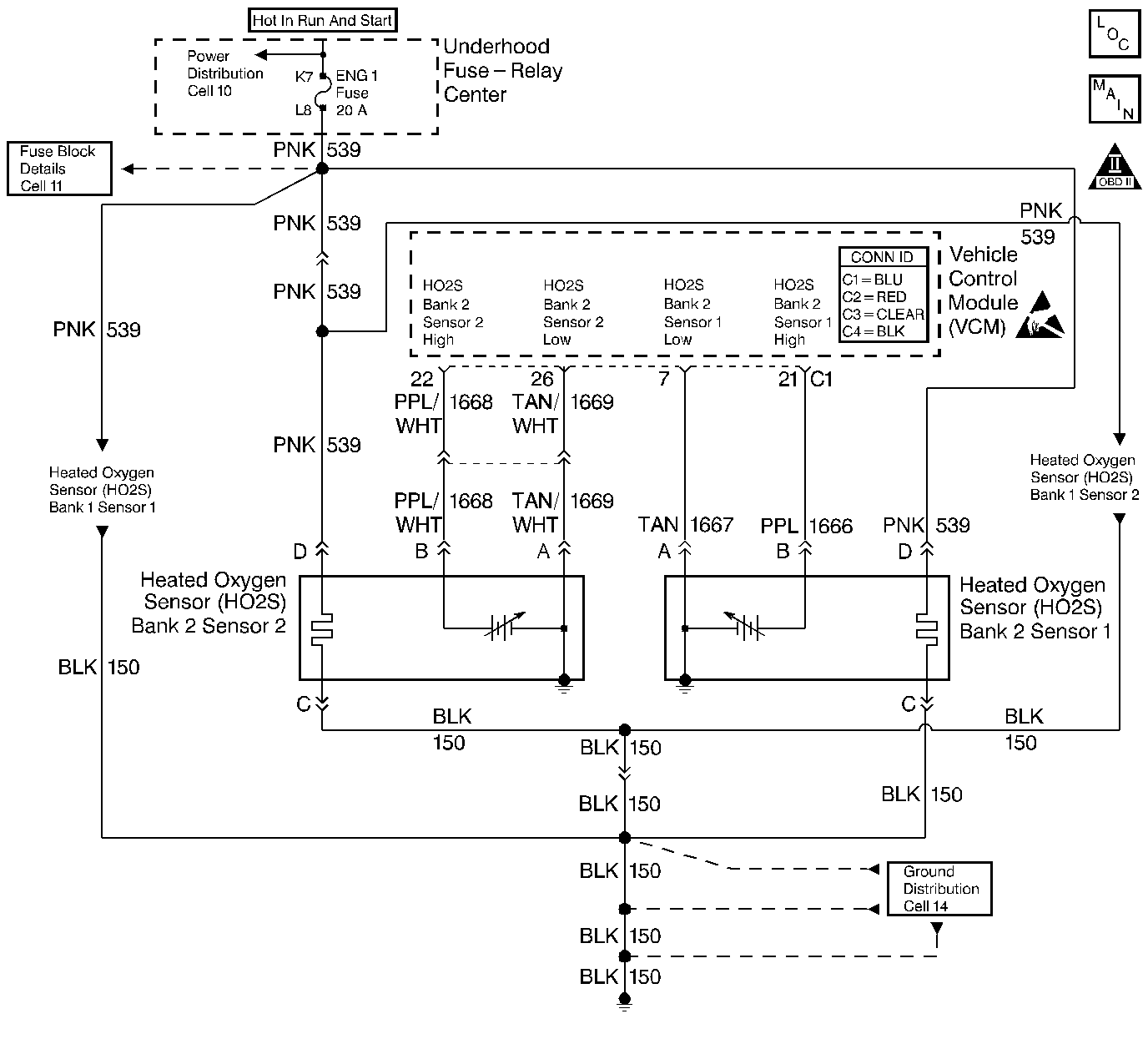
Circuit Description
This diagnostic test is designed in order to measure the efficiency of the three-way catalytic converter (TWC) system. Catalytic convertor efficiency is a measure of its ability to store oxygen after converting the levels of hydrocarbon (HC), carbon monoxide (CO), and oxides of nitrogen (NOx) to less harmful gases. The control module is able to evaluate the catalyst efficiency once the vehicle has met the enable criteria and the vehicle is at idle instead of the steady cruise speeds used in the past.
Once the conditions for running this diagnostic trouble code (DTC) are met, the control module commands either a lean or rich air/fuel ratio depending on the current state of the exhaust oxygen level. The control module issues a rich command if the exhaust is currently lean, or a lean command if the exhaust is currently rich. After completion of the first command, a second and opposite command is issued.
For example, if the control module were to command a rich mixture, the upstream heated oxygen sensor (HO2S) voltage would increase immediately. The rich mixture is delayed in reaching the downstream HO2S due to the conversion process occurring within the converter. The higher the efficiency, the more the delay before the rich or lean mixture is detected by the downstream oxygen (O2) sensor. As a result of the lower conversion efficiency within a damaged or poisoned catalyst, the delay in the rich or lean mixture reaching the downstream O2 sensor is significantly shorter. This DTC monitors the amount of time required for both the upstream and downstream HO2S voltages to cross a calibrated voltage threshold in response to the rich or lean command.
Conditions for Running the DTC
| • | No active VS sensor DTCs |
| • | No active TP sensor DTCs |
| • | No active HO2S DTCs |
| • | No active MAF sensor DTCs |
| • | No active IAT sensor DTCs |
| • | No active fuel trim DTCs |
| • | No active misfire DTCs |
| • | The system is in closed loop |
| • | The commanded air/fuel ratio is 14.7:1 |
| • | The air flow is greater than 15 g/s but less than 50 g/s |
| • | Any change in engine load is less than 10 percent |
| • | The vehicle speed is greater than 20 MPH but less than 85 MPH |
| • | The vehicle speed is greater than 0 MPH with scan tool installed |
| • | The engine speed is less than 4700 RPM |
| • | The throttle position is greater than 2 percent |
| • | The predicted catalyst temperature is greater than 450°C (840°F) |
| • | The IAT is greater than -9°C (16°F) |
| • | The ECT is greater than 75°C (167°F) |
Conditions for Setting the DTC
The VCM determines that the oxygen storage capacity of the catalyst has degraded below a calibrated threshold.
Action Taken When the DTC Sets
| • | The control module illuminates the malfunction indicator lamp (MIL) the first time the diagnostic runs and fails. |
| • | The control module will set the DTC and records the operating conditions at the time the diagnostic fails. The control module stores the failure information in the scan tools Freeze Frame/Failure Records. |
Conditions for Clearing the MIL or DTC
| • | The control module turns OFF the MIL after 3 consecutive drive trips when the test has run and passed. |
| • | A history DTC will clear if no fault conditions have been detected for 40 warm-up cycles. A warm-up cycle occurs when the coolant temperature has risen 22°C (40°F) from the startup coolant temperature and the engine coolant reaches a temperature that is more than 70°C (158°F) during the same ignition cycle. |
| • | Use a scan tool in order to clear the DTCs. |
Diagnostic Aids
The use of fuel with a high sulfur content can degrade a marginal converter's performance. Be sure to check the fuel quality.
Test Description
The numbers below refer to the step numbers in the diagnostic table.
-
This table checks for conditions that can cause the three-way catalytic converter efficiency to appear degraded. Inspect and repair exhaust system as necessary. Refer to Exhaust System Inspection
-
Before the three-way catalytic converter is replaced, make sure that the following conditions are not present:
| • | Misfire |
| • | High engine oil consumption or coolant consumption |
| • | Retarded spark timing or weak spark |
Step | Action | Value(s) | Yes | No | ||||||
|---|---|---|---|---|---|---|---|---|---|---|
1 |
Important: Before clearing the DTCs, use the scan tool Capture Info to save the Freeze Frame and Failure Records for reference. The control module's data is deleted once the Clear Info function is used. Did you perform the Powertrain On-Board Diagnostic (OBD) System Check? | -- | ||||||||
2 | Are any other DTCs set? | -- | Go to the applicable DTC table | |||||||
Did you find a problem? | -- | |||||||||
4 |
Did you find a problem? | -- | ||||||||
5 |
Does the scan tool indicate the diagnostic Passed? | -- | System OK | |||||||
|
Notice: In order to avoid damaging the replacement three-way catalytic converter, correct the engine misfire or mechanical fault before replacing the three-way catalytic converter. Replace the catalytic converter. Refer to Catalytic Converter Replacement in Engine Exhaust. Is the action complete? | -- | System OK | -- |
